Research Project: Analyzing Security of Personal Data on the Internet
VerifiedAdded on 2023/06/14
|6
|1342
|245
Project
AI Summary
This document presents a research project outline focused on the security of personal data on the internet, specifically addressing data theft and privacy concerns related to social networking sites. The research problem is framed around the case study of Facebook and Cambridge Analytica, investigating the importance of securing online data and the preventive measures users can take. The project aims to determine the extent to which personal data is secured on social networking sites, the impact of online data theft, and the steps to mitigate these risks. Employing a mixed-methods approach, the research will collect both qualitative and quantitative data through primary sources like interviews and surveys, supplemented by secondary data from previous data theft instances. The sample includes various stakeholders such as politicians, Cambridge Analytica members, Facebook staff, and general internet users to ensure a comprehensive analysis.
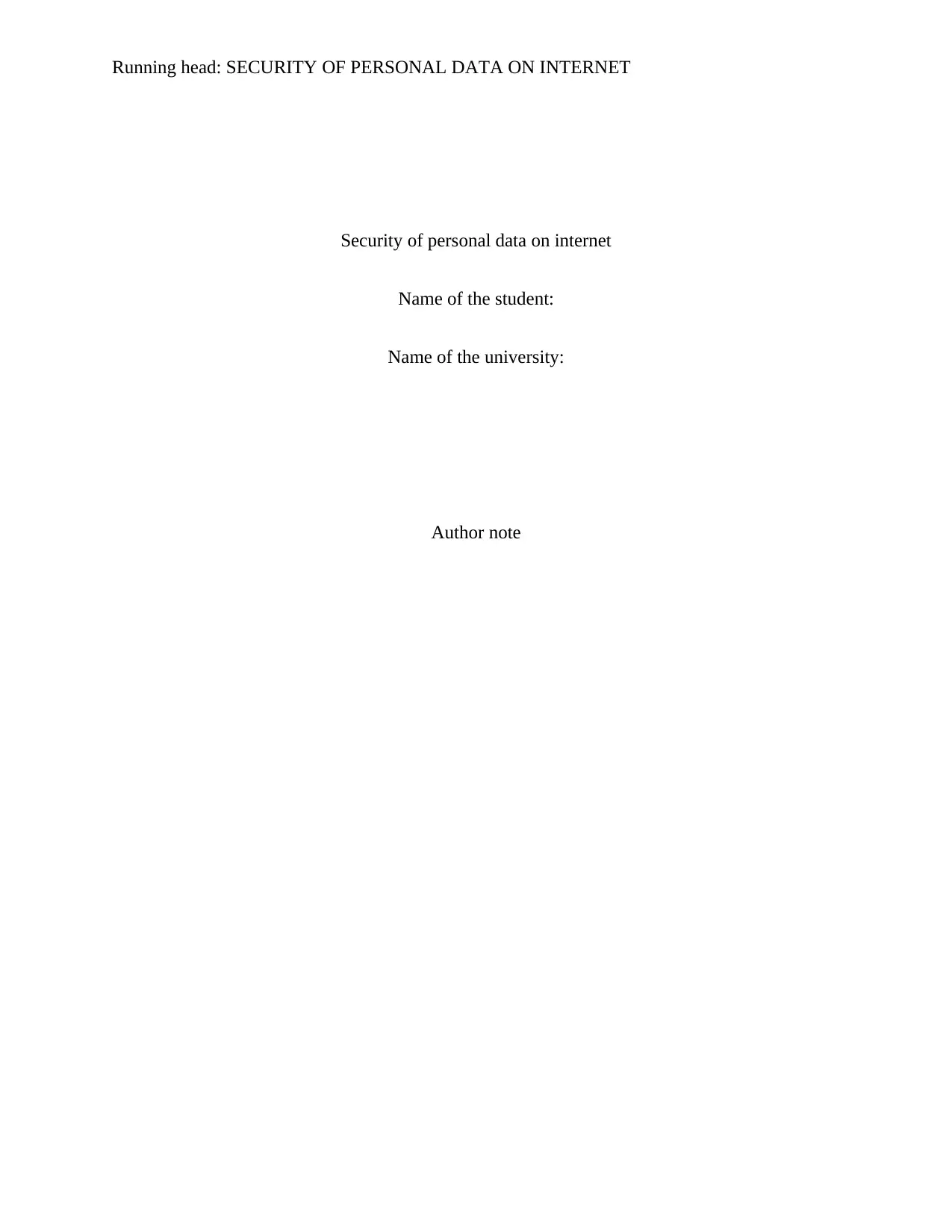
Running head: SECURITY OF PERSONAL DATA ON INTERNET
Security of personal data on internet
Name of the student:
Name of the university:
Author note
Security of personal data on internet
Name of the student:
Name of the university:
Author note
Paraphrase This Document
Need a fresh take? Get an instant paraphrase of this document with our AI Paraphraser
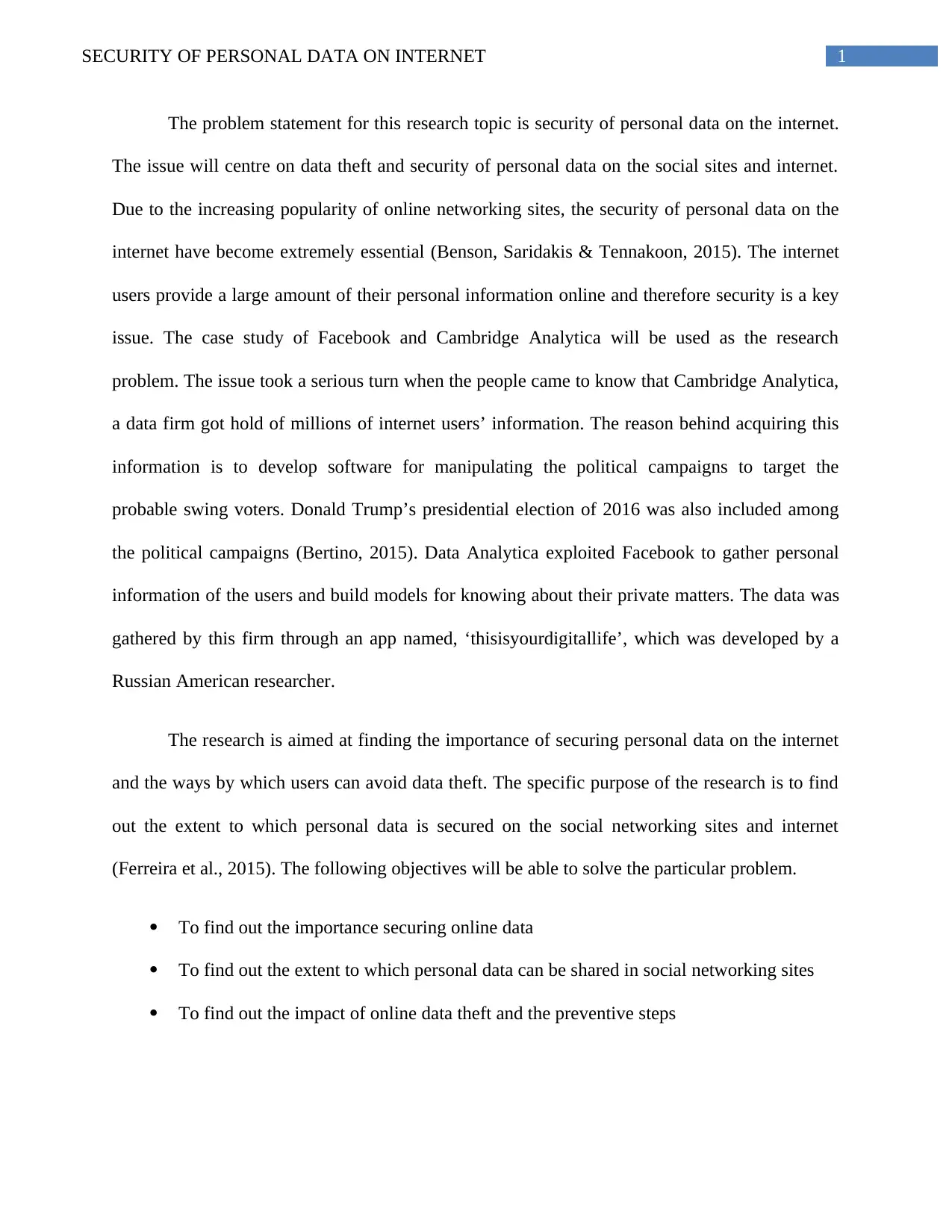
1SECURITY OF PERSONAL DATA ON INTERNET
The problem statement for this research topic is security of personal data on the internet.
The issue will centre on data theft and security of personal data on the social sites and internet.
Due to the increasing popularity of online networking sites, the security of personal data on the
internet have become extremely essential (Benson, Saridakis & Tennakoon, 2015). The internet
users provide a large amount of their personal information online and therefore security is a key
issue. The case study of Facebook and Cambridge Analytica will be used as the research
problem. The issue took a serious turn when the people came to know that Cambridge Analytica,
a data firm got hold of millions of internet users’ information. The reason behind acquiring this
information is to develop software for manipulating the political campaigns to target the
probable swing voters. Donald Trump’s presidential election of 2016 was also included among
the political campaigns (Bertino, 2015). Data Analytica exploited Facebook to gather personal
information of the users and build models for knowing about their private matters. The data was
gathered by this firm through an app named, ‘thisisyourdigitallife’, which was developed by a
Russian American researcher.
The research is aimed at finding the importance of securing personal data on the internet
and the ways by which users can avoid data theft. The specific purpose of the research is to find
out the extent to which personal data is secured on the social networking sites and internet
(Ferreira et al., 2015). The following objectives will be able to solve the particular problem.
To find out the importance securing online data
To find out the extent to which personal data can be shared in social networking sites
To find out the impact of online data theft and the preventive steps
The problem statement for this research topic is security of personal data on the internet.
The issue will centre on data theft and security of personal data on the social sites and internet.
Due to the increasing popularity of online networking sites, the security of personal data on the
internet have become extremely essential (Benson, Saridakis & Tennakoon, 2015). The internet
users provide a large amount of their personal information online and therefore security is a key
issue. The case study of Facebook and Cambridge Analytica will be used as the research
problem. The issue took a serious turn when the people came to know that Cambridge Analytica,
a data firm got hold of millions of internet users’ information. The reason behind acquiring this
information is to develop software for manipulating the political campaigns to target the
probable swing voters. Donald Trump’s presidential election of 2016 was also included among
the political campaigns (Bertino, 2015). Data Analytica exploited Facebook to gather personal
information of the users and build models for knowing about their private matters. The data was
gathered by this firm through an app named, ‘thisisyourdigitallife’, which was developed by a
Russian American researcher.
The research is aimed at finding the importance of securing personal data on the internet
and the ways by which users can avoid data theft. The specific purpose of the research is to find
out the extent to which personal data is secured on the social networking sites and internet
(Ferreira et al., 2015). The following objectives will be able to solve the particular problem.
To find out the importance securing online data
To find out the extent to which personal data can be shared in social networking sites
To find out the impact of online data theft and the preventive steps
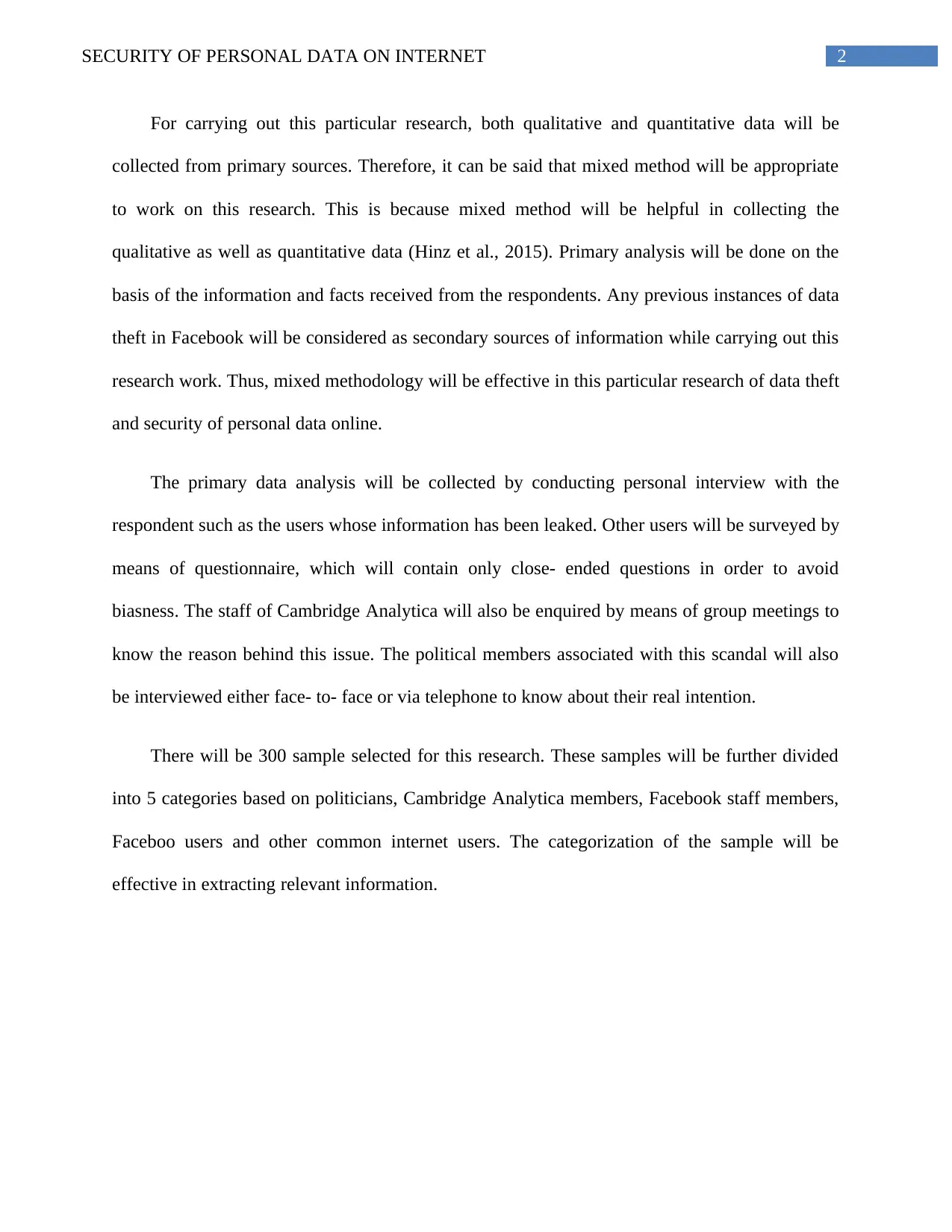
2SECURITY OF PERSONAL DATA ON INTERNET
For carrying out this particular research, both qualitative and quantitative data will be
collected from primary sources. Therefore, it can be said that mixed method will be appropriate
to work on this research. This is because mixed method will be helpful in collecting the
qualitative as well as quantitative data (Hinz et al., 2015). Primary analysis will be done on the
basis of the information and facts received from the respondents. Any previous instances of data
theft in Facebook will be considered as secondary sources of information while carrying out this
research work. Thus, mixed methodology will be effective in this particular research of data theft
and security of personal data online.
The primary data analysis will be collected by conducting personal interview with the
respondent such as the users whose information has been leaked. Other users will be surveyed by
means of questionnaire, which will contain only close- ended questions in order to avoid
biasness. The staff of Cambridge Analytica will also be enquired by means of group meetings to
know the reason behind this issue. The political members associated with this scandal will also
be interviewed either face- to- face or via telephone to know about their real intention.
There will be 300 sample selected for this research. These samples will be further divided
into 5 categories based on politicians, Cambridge Analytica members, Facebook staff members,
Faceboo users and other common internet users. The categorization of the sample will be
effective in extracting relevant information.
For carrying out this particular research, both qualitative and quantitative data will be
collected from primary sources. Therefore, it can be said that mixed method will be appropriate
to work on this research. This is because mixed method will be helpful in collecting the
qualitative as well as quantitative data (Hinz et al., 2015). Primary analysis will be done on the
basis of the information and facts received from the respondents. Any previous instances of data
theft in Facebook will be considered as secondary sources of information while carrying out this
research work. Thus, mixed methodology will be effective in this particular research of data theft
and security of personal data online.
The primary data analysis will be collected by conducting personal interview with the
respondent such as the users whose information has been leaked. Other users will be surveyed by
means of questionnaire, which will contain only close- ended questions in order to avoid
biasness. The staff of Cambridge Analytica will also be enquired by means of group meetings to
know the reason behind this issue. The political members associated with this scandal will also
be interviewed either face- to- face or via telephone to know about their real intention.
There will be 300 sample selected for this research. These samples will be further divided
into 5 categories based on politicians, Cambridge Analytica members, Facebook staff members,
Faceboo users and other common internet users. The categorization of the sample will be
effective in extracting relevant information.
⊘ This is a preview!⊘
Do you want full access?
Subscribe today to unlock all pages.

Trusted by 1+ million students worldwide
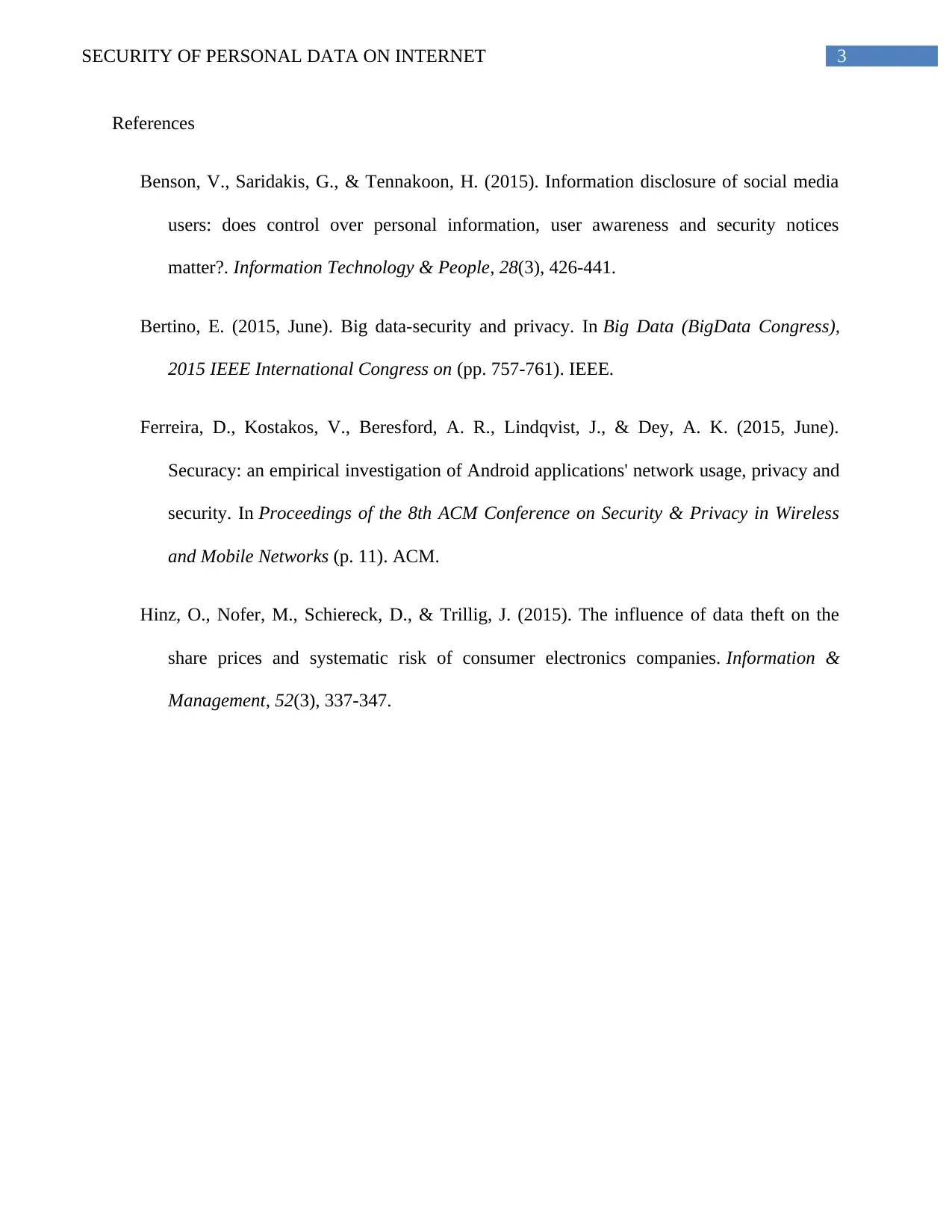
3SECURITY OF PERSONAL DATA ON INTERNET
References
Benson, V., Saridakis, G., & Tennakoon, H. (2015). Information disclosure of social media
users: does control over personal information, user awareness and security notices
matter?. Information Technology & People, 28(3), 426-441.
Bertino, E. (2015, June). Big data-security and privacy. In Big Data (BigData Congress),
2015 IEEE International Congress on (pp. 757-761). IEEE.
Ferreira, D., Kostakos, V., Beresford, A. R., Lindqvist, J., & Dey, A. K. (2015, June).
Securacy: an empirical investigation of Android applications' network usage, privacy and
security. In Proceedings of the 8th ACM Conference on Security & Privacy in Wireless
and Mobile Networks (p. 11). ACM.
Hinz, O., Nofer, M., Schiereck, D., & Trillig, J. (2015). The influence of data theft on the
share prices and systematic risk of consumer electronics companies. Information &
Management, 52(3), 337-347.
References
Benson, V., Saridakis, G., & Tennakoon, H. (2015). Information disclosure of social media
users: does control over personal information, user awareness and security notices
matter?. Information Technology & People, 28(3), 426-441.
Bertino, E. (2015, June). Big data-security and privacy. In Big Data (BigData Congress),
2015 IEEE International Congress on (pp. 757-761). IEEE.
Ferreira, D., Kostakos, V., Beresford, A. R., Lindqvist, J., & Dey, A. K. (2015, June).
Securacy: an empirical investigation of Android applications' network usage, privacy and
security. In Proceedings of the 8th ACM Conference on Security & Privacy in Wireless
and Mobile Networks (p. 11). ACM.
Hinz, O., Nofer, M., Schiereck, D., & Trillig, J. (2015). The influence of data theft on the
share prices and systematic risk of consumer electronics companies. Information &
Management, 52(3), 337-347.
Paraphrase This Document
Need a fresh take? Get an instant paraphrase of this document with our AI Paraphraser
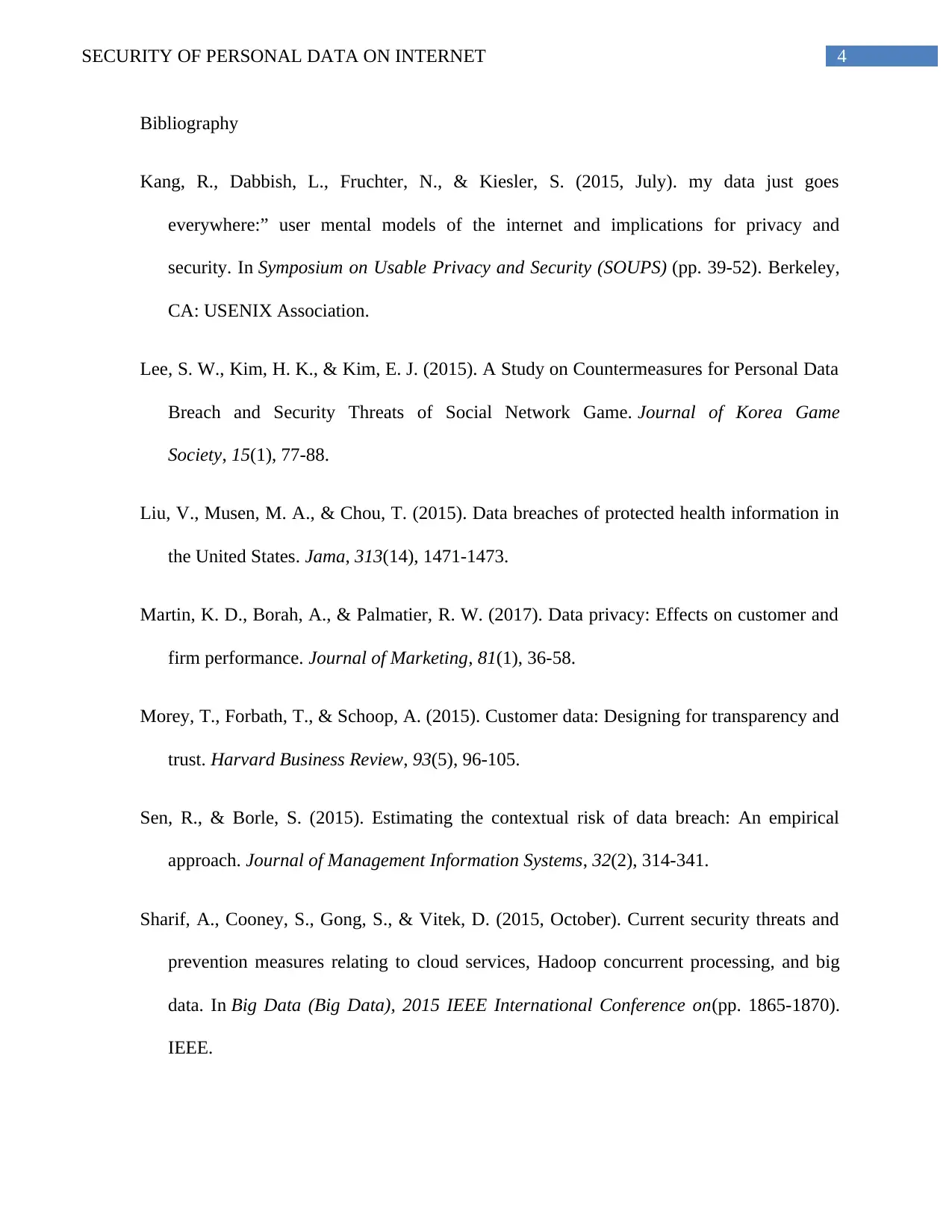
4SECURITY OF PERSONAL DATA ON INTERNET
Bibliography
Kang, R., Dabbish, L., Fruchter, N., & Kiesler, S. (2015, July). my data just goes
everywhere:” user mental models of the internet and implications for privacy and
security. In Symposium on Usable Privacy and Security (SOUPS) (pp. 39-52). Berkeley,
CA: USENIX Association.
Lee, S. W., Kim, H. K., & Kim, E. J. (2015). A Study on Countermeasures for Personal Data
Breach and Security Threats of Social Network Game. Journal of Korea Game
Society, 15(1), 77-88.
Liu, V., Musen, M. A., & Chou, T. (2015). Data breaches of protected health information in
the United States. Jama, 313(14), 1471-1473.
Martin, K. D., Borah, A., & Palmatier, R. W. (2017). Data privacy: Effects on customer and
firm performance. Journal of Marketing, 81(1), 36-58.
Morey, T., Forbath, T., & Schoop, A. (2015). Customer data: Designing for transparency and
trust. Harvard Business Review, 93(5), 96-105.
Sen, R., & Borle, S. (2015). Estimating the contextual risk of data breach: An empirical
approach. Journal of Management Information Systems, 32(2), 314-341.
Sharif, A., Cooney, S., Gong, S., & Vitek, D. (2015, October). Current security threats and
prevention measures relating to cloud services, Hadoop concurrent processing, and big
data. In Big Data (Big Data), 2015 IEEE International Conference on(pp. 1865-1870).
IEEE.
Bibliography
Kang, R., Dabbish, L., Fruchter, N., & Kiesler, S. (2015, July). my data just goes
everywhere:” user mental models of the internet and implications for privacy and
security. In Symposium on Usable Privacy and Security (SOUPS) (pp. 39-52). Berkeley,
CA: USENIX Association.
Lee, S. W., Kim, H. K., & Kim, E. J. (2015). A Study on Countermeasures for Personal Data
Breach and Security Threats of Social Network Game. Journal of Korea Game
Society, 15(1), 77-88.
Liu, V., Musen, M. A., & Chou, T. (2015). Data breaches of protected health information in
the United States. Jama, 313(14), 1471-1473.
Martin, K. D., Borah, A., & Palmatier, R. W. (2017). Data privacy: Effects on customer and
firm performance. Journal of Marketing, 81(1), 36-58.
Morey, T., Forbath, T., & Schoop, A. (2015). Customer data: Designing for transparency and
trust. Harvard Business Review, 93(5), 96-105.
Sen, R., & Borle, S. (2015). Estimating the contextual risk of data breach: An empirical
approach. Journal of Management Information Systems, 32(2), 314-341.
Sharif, A., Cooney, S., Gong, S., & Vitek, D. (2015, October). Current security threats and
prevention measures relating to cloud services, Hadoop concurrent processing, and big
data. In Big Data (Big Data), 2015 IEEE International Conference on(pp. 1865-1870).
IEEE.
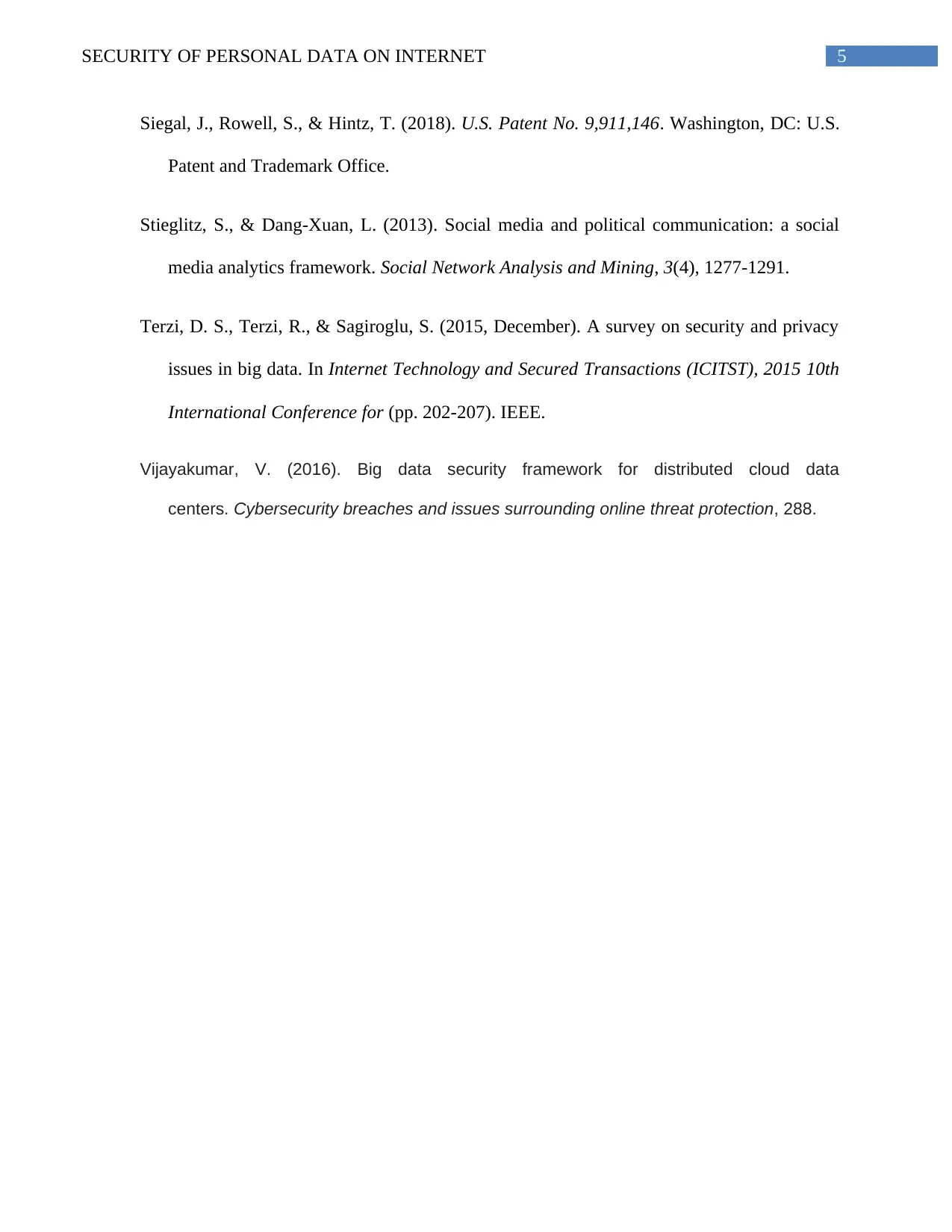
5SECURITY OF PERSONAL DATA ON INTERNET
Siegal, J., Rowell, S., & Hintz, T. (2018). U.S. Patent No. 9,911,146. Washington, DC: U.S.
Patent and Trademark Office.
Stieglitz, S., & Dang-Xuan, L. (2013). Social media and political communication: a social
media analytics framework. Social Network Analysis and Mining, 3(4), 1277-1291.
Terzi, D. S., Terzi, R., & Sagiroglu, S. (2015, December). A survey on security and privacy
issues in big data. In Internet Technology and Secured Transactions (ICITST), 2015 10th
International Conference for (pp. 202-207). IEEE.
Vijayakumar, V. (2016). Big data security framework for distributed cloud data
centers. Cybersecurity breaches and issues surrounding online threat protection, 288.
Siegal, J., Rowell, S., & Hintz, T. (2018). U.S. Patent No. 9,911,146. Washington, DC: U.S.
Patent and Trademark Office.
Stieglitz, S., & Dang-Xuan, L. (2013). Social media and political communication: a social
media analytics framework. Social Network Analysis and Mining, 3(4), 1277-1291.
Terzi, D. S., Terzi, R., & Sagiroglu, S. (2015, December). A survey on security and privacy
issues in big data. In Internet Technology and Secured Transactions (ICITST), 2015 10th
International Conference for (pp. 202-207). IEEE.
Vijayakumar, V. (2016). Big data security framework for distributed cloud data
centers. Cybersecurity breaches and issues surrounding online threat protection, 288.
⊘ This is a preview!⊘
Do you want full access?
Subscribe today to unlock all pages.

Trusted by 1+ million students worldwide
1 out of 6
Related Documents
Your All-in-One AI-Powered Toolkit for Academic Success.
+13062052269
info@desklib.com
Available 24*7 on WhatsApp / Email
![[object Object]](/_next/static/media/star-bottom.7253800d.svg)
Unlock your academic potential
Copyright © 2020–2025 A2Z Services. All Rights Reserved. Developed and managed by ZUCOL.





